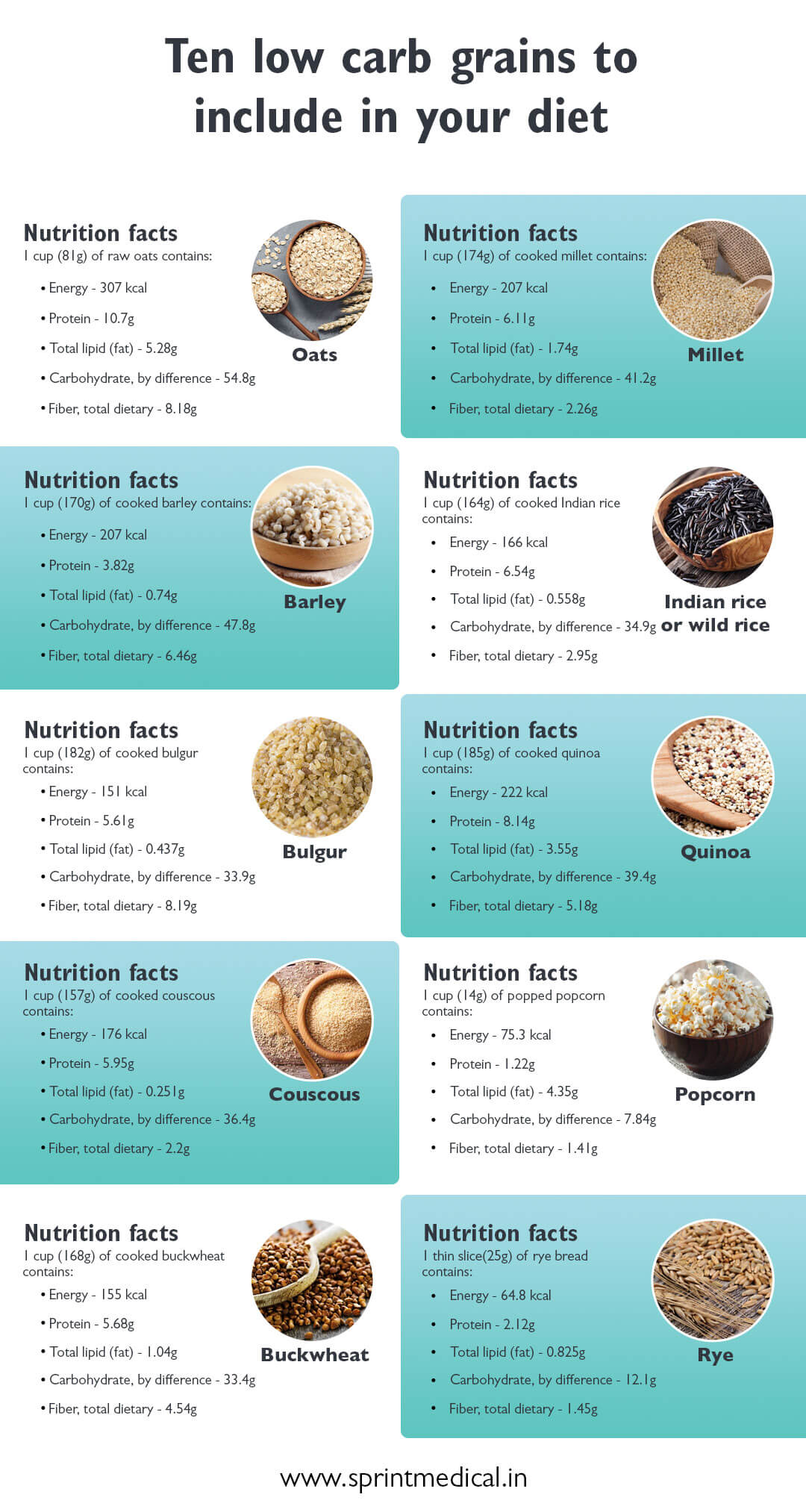Ten low-carb grains to include in your diet
Ten low-carb grains to include in your diet

1. Oats
Nutrition facts
1 cup (81g) of raw oats contains:
Energy - 307 kcal
Protein - 10.7g
Total lipid (fat) - 5.28g
Carbohydrate, by difference - 54.8g
Fiber, total dietary - 8.18g
Oats are admiringly nutritious and contain various micronutrients, including phosphorus, manganese, thiamine, and magnesium. It is also a good source of beta-glucan, a fiber that helps reduce LDL (bad) cholesterol levels. High levels of bad cholesterol are a risk factor for heart disease. Experts recommend rolled oats or steel-cut instead of highly processed types, such as instant oatmeal.
2. Millet
Nutrition facts
1 cup (174g) of cooked millet contains:
Energy - 207 kcal
Protein - 6.11g
Total lipid (fat) - 1.74g
Carbohydrate, by difference - 41.2g
Fiber, total dietary - 2.26g
Millet is relatively low in net carbs and a good source of fiber. Additionally, millet contains polyphenols and antioxidants, which may help prevent type 2 diabetes.
3. Barley
Nutrition facts
1 cup (170g) of cooked barley contains:
Energy - 207 kcal
Protein - 3.82g
Total lipid (fat) - 0.74g
Carbohydrate, by difference - 47.8g
Fiber, total dietary - 6.46g
Barley is a nutritious grain special for its chewy texture and nutty flavor. Barley is an excellent magnesium, selenium, manganese, copper, and zinc source. However, it is best to use hulled barley rather than pearled barley, as it is less processed and is considered a whole grain.
4. Indian rice or wild rice
Nutrition facts
1 cup (164g) of cooked Indian rice contains:
Energy - 166 kcal
Protein - 6.54g
Total lipid (fat) - 0.558g
Carbohydrate, by difference - 34.9g
Fiber, total dietary - 2.95g
Wild rice is significantly low in carbs than other types of rice and is rich in health-promoting antioxidants.
The phenolic compounds in wild rice showed 10 times the antioxidant activity of those in white rice. Moreover, wild rice is an excellent source of several other nutrients, including vitamin B6, zinc, and folate.
5. Bulgur
Nutrition facts
1 cup (182g) of cooked bulgur contains:
Energy - 151 kcal
Protein - 5.61g
Total lipid (fat) - 0.437g
Carbohydrate, by difference - 33.9g
Fiber, total dietary - 8.19g
Bulgur is a highly nutritious type of grain made from cracked wheat berries. Tabbouleh salad, pilaf, and porridge are some dishes prepared using bulgur. It’s also a great source of iron, manganese, B vitamins, and magnesium.
6. Quinoa
Nutrition facts
1 cup (185g) of cooked quinoa contains:
Energy - 222 kcal
Protein - 8.14g
Total lipid (fat) - 3.55g
Carbohydrate, by difference - 39.4g
Fiber, total dietary - 5.18g
Rich in beneficial polyphenols and antioxidants, quinoa can help reduce inflammation and protect against chronic disease. Quinoa is a plant-based complete protein source. It contains all nine essential amino acids the body needs from food sources. Additionally, quinoa contains other vital nutrients, including manganese, phosphorus, magnesium, folate, and copper.
7. Couscous
Nutrition facts
1 cup (157g) of cooked couscous contains:
Energy - 176 kcal
Protein - 5.95g
Total lipid (fat) - 0.251g
Carbohydrate, by difference - 36.4g
Fiber, total dietary - 2.2g
Couscous is a processed grain product made from durum wheat or semolina flour.
Couscous is a common ingredient in many Moroccan and Middle Eastern dishes. Couscous is rich in selenium, a trace mineral that plays a vital role in heart health, immune health, thyroid function, and more. Adding couscous to the diet can also boost the intake of several other essential micronutrients, including manganese, copper, thiamine, and pantothenic acid.
8. Popcorn
Nutrition facts
1 cup (14g) of popped popcorn contains:
Energy - 75.3 kcal
Protein - 1.22g
Total lipid (fat) - 4.35g
Carbohydrate, by difference - 7.84g
Fiber, total dietary - 1.41g
Technically, popcorn is a whole grain. It is a low-calorie, low-carb grain high in iron, vitamin B, magnesium, and phosphorus. However, choose air-popped popcorn over other varieties with added sugars, unhealthy fats, and artificial flavorings.
9. Buckwheat
Nutrition facts
1 cup (168g) of cooked buckwheat contains:
Energy - 155 kcal
Protein - 5.68g
Total lipid (fat) - 1.04g
Carbohydrate, by difference - 33.4g
Fiber, total dietary - 4.54g
Buckwheat is a highly nutritious whole grain and is gluten-free. Moreover, buckwheat flour and buckwheat are excellent dietary alternatives for people with gluten intolerances or celiac disease.
10. Rye
Nutrition facts
1 thin slice(25g) of rye bread contains:
Energy - 64.8 kcal
Protein - 2.12g
Total lipid (fat) - 0.825g
Carbohydrate, by difference - 12.1g
Fiber, total dietary - 1.45g
Rye is a nutrient-dense grain. Rye bread, which is high in fiber, is the best way to add rye to the diet.
Comments
Post a Comment